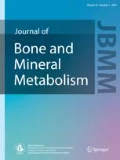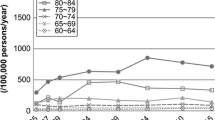Abstract
Incidence of hip fracture in dialysis patients is significantly higher than that in the general population. As information is lacking about Asian dialysis patients, we compared the incidence of hip fracture in hemodialysis patients with that in the general population in Japan. We conducted a retrospective cohort study using panel data from the Japanese Society for Dialysis Therapy registry. The study included patients without history of hip fracture who received hemodialysis three times per week as of December 31, 2007. We compared the observed number of hip fractures to the expected number derived from a national survey, and calculated standardized incidence ratios (SIRs) and the incidence rate difference. Subgroup analysis was performed according to vintage and diabetic status. During the one-year study period, 1,437 hip fractures were recorded in the 128,141 hemodialysis patients (61.9 % male). The overall incidence was 7.57 and 17.43 per 1,000 person-years in men and women, respectively. The SIRs for male and female patients were 6.2 [95 % confidence interval (CI) 5.7–6.8] and 4.9 (95 % CI 4.6–5.3) compared to the general population, and remained nearly constant until 16 years vintage, but increased steeply thereafter. The incidence rate difference of hip fracture increased with age. The SIRs for diabetics of both genders were higher than those for non-diabetics. Our study provides additional evidence that hip fracture risk among Asian dialysis patients is also significantly higher than in the general population.



Similar content being viewed by others
References
Coco M, Rush H (2000) Increased incidence of hip fractures in dialysis patients with low serum parathyroid hormone. Am J Kidney Dis 36:1115–1121
Danese MD, Kim J, Doan QV, Dylan M, Griffiths R, Chertow GM (2006) PTH and the risks for hip, vertebral, and pelvic fractures among patients on dialysis. Am J Kidney Dis 47:149–156
Meguid El Nahas A, Bello AK (2005) Chronic kidney disease: the global challenge. Lancet 365:331–340
Nakai S, Suzuki K, Masakane I, Wada A, Itami N et al (2010) An overview of regular dialysis treatment in Japan (as of 31 December 2008). Ther Apher Dial 14:505–540
Alem AM, Sherrard DJ, Gillen DL, Weiss NS, Beresford SA, Heckbert SR, Wong C, Stehman-Breen C (2000) Increased risk of hip fracture among patients with end-stage renal disease. Kidney Int 58:396–399
Jadoul M, Albert JM, Akiba T, Akizawa T, Arab L, Bragg-Gresham JL, Mason N, Prutz KG, Young EW, Pisoni RL (2006) Incidence and risk factors for hip or other bone fractures among hemodialysis patients in the Dialysis Outcomes and Practice Patterns Study. Kidney Int 70:1358–1366
Ross PD, Norimatsu H, Davis JW, Yano K, Wasnich RD, Fujiwara S, Hosoda Y, Melton LJ 3rd (1991) A comparison of hip fracture incidence among native Japanese, Japanese Americans, and American Caucasians. Am J Epidemiol 133:801–809
Hagino H, Yamamoto K, Ohshiro H, Nakamura T, Kishimoto H, Nose T (1999) Changing incidence of hip, distal radius, and proximal humerus fractures in Tottori prefecture, Japan. Bone 24:265–270
Kin K, Lee JH, Kushida K, Sartoris DJ, Ohmura A, Clopton PL, Inoue T (1993) Bone density and body composition on the Pacific rim: a comparison between Japan-born and U.S.-born Japanese-American women. J Bone Miner Res 8:861–869
Greendale GA, Young JT, Huang MH, Bucur A, Wang Y, Seeman T (2003) Hip axis length in mid-life Japanese and Caucasian U.S. residents: no evidence for an ethnic difference. Osteoporos Int 14:320–325
Shinzato T, Nakai S, Akiba T, Yamagami S, Yamazaki C, Kitaoka T, Kubo K, Maeda K, Morii H (1999) Report on the annual statistical survey of the Japanese Society for Dialysis Therapy in 1996. Kidney Int 55:700–712
Iseki K, Shoji T, Nakai S, Watanabe Y, Akiba T, Tsubakihara Y, Committee of Renal Data Registry of the Japanese Society for Dialysis Therapy (2009) Higher survival rates of chronic hemodialysis patients on anti-hypertensive drugs. Nephron Clin Pract 113:c183–c190
Wakai K, Nakai S, Kikuchi K, Iseki K, Miwa N, Masakane I, Wada A, Shinzato T, Nagura Y, Akiba T (2004) Trends in incidence of end-stage renal disease in Japan, 1983–2000: age-adjusted and age-specific rates by gender and cause. Nephrol Dial Transplant 19:2044–2052
Morris JA, Gardner MJ (2000) Epidemiological studies. In: Altman DG, Machin D, Bryant TN, Gardner MJ (eds) Statistics with confidence, 2nd edn. BMJ Books, London, pp 57–72
Tripepi G, Jager KJ, Dekker FW, Zoccali C (2010) Stratification for confounding—part 2: direct and indirect standardization. Nephron Clin Pract 116:c322–c325
Orimo H, Yaegashi Y, Onoda T, Fukushima Y, Hosoi T, Sakata K (2009) Hip fracture incidence in Japan: estimates of new patients in 2007 and 20-year trends. Arch Osteoporos 4:71–77
Tripepi G, Jager KJ, Dekker FW, Zoccali C (2010) Measures of effect in epidemiological research. Nephron Clin Pract 115:c91–c93
Fried LF, Biggs ML, Shlipak MG, Seliger S, Kestenbaum B, Stehman-Breen C, Sarnak M, Siscovick D, Harris T, Cauley J, Newman AB, Robbins J (2007) Association of kidney function with incident hip fracture in older adults. J Am Soc Nephrol 18:282–286
Nickolas TL, McMahon DJ, Shane E (2006) Relationship between moderate to severe kidney disease and hip fracture in the United States. J Am Soc Nephrol 17:3223–3232
Dooley AC, Weiss NS, Kestenbaum B (2008) Increased risk of hip fracture among men with CKD. Am J Kidney Dis 51:38–44
Ball AM, Gillen DL, Sherrard D, Weiss NS, Emerson SS, Seliger SL, Kestenbaum BR, Stehman-Breen C (2002) Risk of hip fracture among dialysis and renal transplant recipients. JAMA 288:3014–3018
Kidney Disease: Improving Global Outcomes (KDIGO) CKD-MBD Work Group (2009) KDIGO clinical practice guideline for the diagnosis, evaluation, prevention, and treatment of chronic kidney disease-mineral and bone disorder (CKD-MBD). Kidney Int Suppl 113:S1–130
Goldsmith D, Kothawala P, Chalian A, Bernal M, Robbins S, Covic A (2009) Systematic review of the evidence underlying the association between mineral metabolism disturbances and risk of fracture and need for parathyroidectomy in CKD. Am J Kidney Dis 53:1002–1013
Patel S, Barron JL, Mirzazedeh M, Gallagher H, Hyer S, Cantor T, Fraser WD (2010) Changes in bone mineral parameters, vitamin D metabolites, and PTH measurements with varying chronic kidney disease stages. J Bone Miner Metab 29:71–79
Kazama JJ, Yamamoto S, Takahashi N, Ito Y, Maruyama H, Narita I, Gejyo F (2006) Abeta-2M-amyloidosis and related bone disease. J Bone Miner Metab 24:182–184
Yamamoto S, Kazama JJ, Maruyama H, Nishi S, Narita I, Gejyo F (2008) Patients undergoing dialysis therapy for 30 years or more survive with serious osteoarticular disorders. Clin Nephrol 70:496–502
Desmet C, Beguin C, Swine C, Jadoul M, Université Catholique de Louvain Collaborative Group (2005) Falls in hemodialysis patients: prospective study of incidence, risk factors, and complications. Am J Kidney Dis 45:148–153
Cook WL, Tomlinson G, Donaldson M, Markowitz SN, Naglie G, Sobolev B, Jassal SV (2006) Falls and fall-related injuries in older dialysis patients. Clin J Am Soc Nephrol 1:1197–1204
Acknowledgments
These data were presented in part at the annual meeting of the American Society of Nephrology, December 15–19, 2011, Philadelphia, PA. Data were obtained with the permission of the Committee of Renal Data Registry of the Japanese Society for Dialysis Therapy. We used the standard analysis file (JRDR-09001) for this study. The opinions reflected in this manuscript are those of the authors alone and do not reflect an official position of the Japanese Society for Dialysis Therapy. This study was supported in part by a Grant-in-Aid for Progressive Renal Diseases Research, Research on Intractable Disease, from the Ministry of Health, Labor, and Welfare of Japan.
Conflict of interest
The authors have no conflicts of interest to declare.
Author information
Authors and Affiliations
Corresponding author
Appendix
Appendix
In this Appendix we provide a mathematical basis for the estimation method of the incidence of hip fracture in this study.
If x is the observed number of individuals with the outcome of interest (i.e., hip fracture onset), and Py the number of person-years at risk, the incidence rate (IR) is given by
The number of person-years at risk is obtained as a sum of the patient’s time at risk who suffered hip fracture (Pfy) and did not (Pny).
If a patient did not suffer a hip fracture, the patient’s time at risk of these patients (Pny) is equal to the patient’s survival time during the 1-year study period (Psny).
If a patient suffered a hip fracture, we assume the patient’s time at risk of these patients (Pfy) is equal to half of Psfy the patient’s survival time during the study.
This assumption is considered reasonable as no seasonal trends associated with the incidence of hip fractures have been detected in the general Japanese population [ref. 8].
In addition, as only a small number of hip fractures were reported, the total patient time at risk estimated using this method did not significantly change when this assumption was changed as below. For male hemodialysis patients,x = 595, Psny = 78,319.5388 years, Psfy = 592.75 years,
If we assume that all fractured patients were suffered on the last day (i.e., equal to the patient’s survival time during the study), the IR was calculated as below
If we assume that all fractured patients were suffered on the first study day (i.e., January 1st), the patient’s time at risk of these patients (Pfy) is calculated as follow
Thus, the IR was calculated as below
Same as above, for female hemodialysis patients,x = 842, Psny = 47,879.5 years, Psfy = 832.58333 years,
If we assume that all fractured patients were suffered on the last day (i.e., equal to the patient’s survival time during the study), the IR was calculated as below
If we assume that all fractured patients were suffered on the first study day (i.e., January 1st), the patient’s time at risk of these patients (Pfy) is calculated as follow
Thus, the IR was calculated as below
In conclusion, application of this estimation method did not significantly affect the study results according to our trial calculation. Our assumption is considered reasonable (Fig. 4).
About this article
Cite this article
Wakasugi, M., Kazama, J.J., Taniguchi, M. et al. Increased risk of hip fracture among Japanese hemodialysis patients. J Bone Miner Metab 31, 315–321 (2013). https://doi.org/10.1007/s00774-012-0411-z
Received:
Accepted:
Published:
Issue Date:
DOI: https://doi.org/10.1007/s00774-012-0411-z





